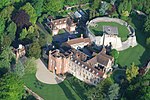Willmer House

Willmer House is a grade I listed building in Farnham, Surrey, in England. Built in 1718 for a local hop merchant the building later became a school and dental surgery. Since 1961 it has housed the Museum of Farnham. The building was purchased by Waverley Borough Council from Surrey County Council in 2012. Willmer House is Baroque in style and features an elaborate red-brick façade, described by the Pevsner Architectural Guide as one of the finest in the country. Architectural historian Nathaniel Lloyd, in 1929, described the pilasters at either end of the façade as "perhaps the most beautiful example extant of the Doric order interpreted in brick". A restoration of the façade in 2017 revealed it was in need of more significant repair than had been thought. Since 2018 scaffolding has been in place to protect the public from falling masonry. The council applied for Arts Council England funding in 2022 to part-fund the repairs.
Excerpt from the Wikipedia article Willmer House (License: CC BY-SA 3.0, Authors, Images).Willmer House
West Street, Waverley
Geographical coordinates (GPS) Address Nearby Places Show on map
Geographical coordinates (GPS)
| Latitude | Longitude |
|---|---|
| N 51.2132 ° | E -0.8045 ° |
Address
West Street 38
GU9 7EN Waverley
England, United Kingdom
Open on Google Maps








